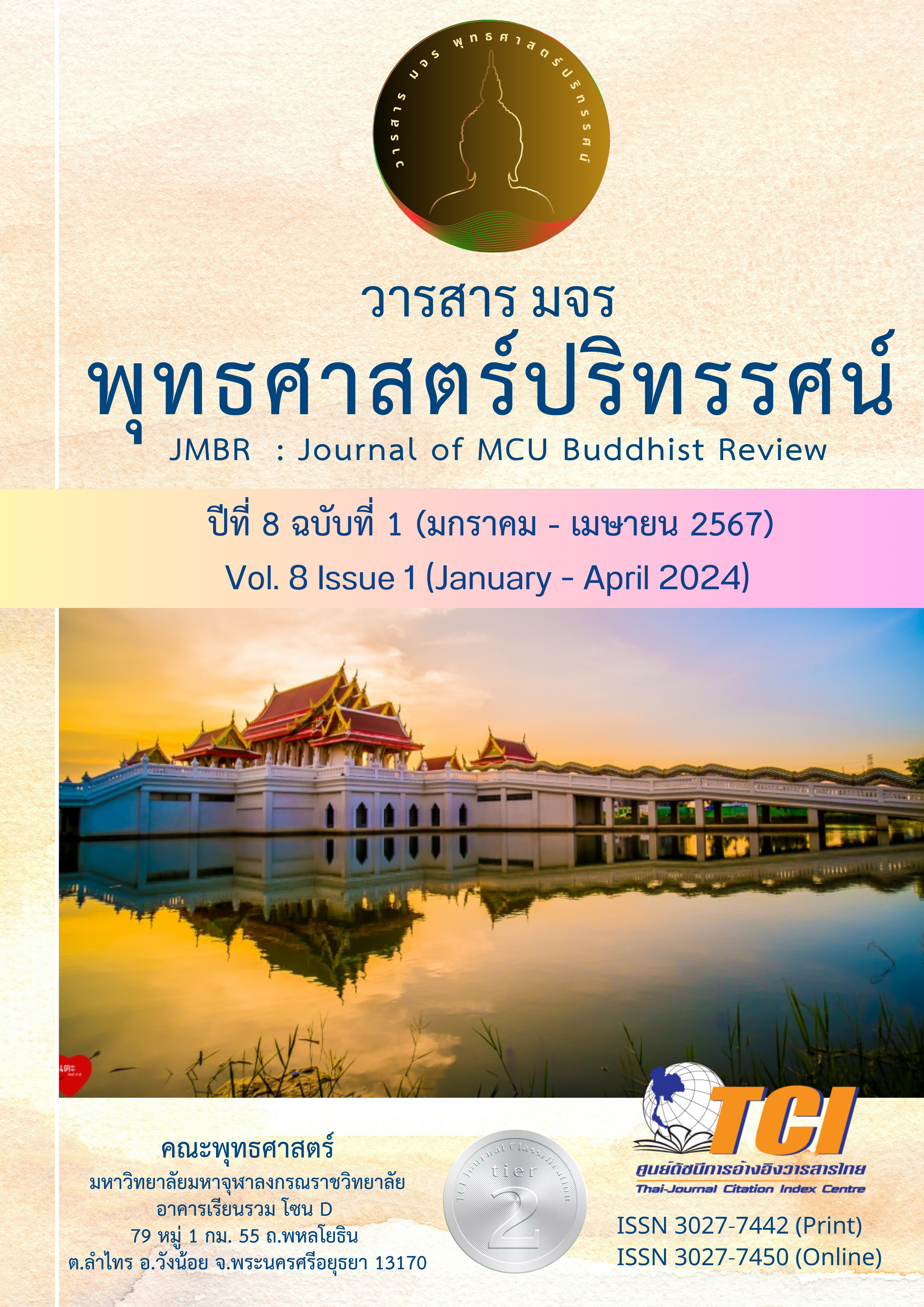หลักธรรมที่นำไปปฏิบัติเพื่อการหลุดพ้นกิเลสในพระพุทธศาสนาเถรวาท
Main Article Content
บทคัดย่อ
บทความวิชาการนี้มุ่งนำเสนอหลักธรรมเพื่อความหลุดพ้นจากกิเลสที่ทำให้ใจเกิดความเศร้าหมอง ขุ่นมัว ซึ่งกิเลสมีอยู่ 3 ประเภทใหญ่ ๆ คือ โลภะ โทสะ และโมหะ แยกออกเป็นกิเลส 3 อย่างคือ กิเลสอย่างหยาบ กิเลสอย่างกลาง และกิเลสอย่างละเอียด กิเลสเหล่านี้ล้วนเป็นเหตุปัจจัยก่อให้เกิดทุกข์ ตามธรรมดากิเลสนั้นมีคุณน้อย มีโทษมาก และมีความร้ายแรง มนุษย์หากไม่ประกอบด้วยสติปัญญาเป็นเครื่องกำกับก็จะไม่สามารถรู้เท่าทันกิเลสได้ และยังก่อให้เกิดความเดือดร้อนแก่ตนเองและผู้อื่น ไม่สามารถบรรลุมรรคผล สำหรับนักปฏิบัติธรรมจะพิจารณากิเลสเป็นตัวการสำคัญที่คอยขวางกั้นไม่ให้มนุษย์บรรลุถึงความดีหรือความจริงอันสูงสุด หลักธรรมเพื่อการหลุดพ้นกิเลสในพระพุทธศาสนาเถรวาท พบว่า ตามหลักพระพุทธศาสนามีหลักธรรมที่นำมาใช้ปฏิบัติอยู่อย่างมากมาย หลักธรรมล้วนแต่เชื่อมโยงกันได้เป็นอย่างดี หลักธรรมที่เรียกว่า โพธิปักขิยธรรม 37 ประการ คือ สติปัฏฐาน 4 สัมมัปธาน 4 อิทธิบาท 4 อินทรีย์ 5 พละ 5 โพชฌงค์ 7 และ มรรคมีองค์ 8 เป็นธรรมที่มีความสำคัญมาก เพราะเป็นเครื่องมืออันเป็นเหตุแห่งการตัดกิเลส แล้วก้าวสู่การบรรลุมรรคผลนิพพาน ผู้ปฏิบัติจึงควรนำหลักธรรมเหล่านี้ไปใช้ในการปฏิบัติ เพื่อให้เกิดความรู้ ความเข้าใจในการปฏิบัติเพื่อให้เกิดความหลุดพ้นจากความทุกข์ได้ นั่นเอง วิธีการปฏิบัติตนเพื่อนำไปสู่การหลุดพ้นกิเลสในพระพุทธศาสนาเถรวาท พบว่า ควรดำรงชีวิตของตนที่ตั้งอยู่ในศีลเป็นเบื้องต้น หลักธรรมที่เกื้อหนุนให้เกิดสมาธิ คือ หลักโพธิปักขิยธรรม 37 ประการ โดยการปฏิบัติสมถะและวิปัสสนากรรมฐานเพื่อประหารกิเลสอย่างหยาบ กิเลสอย่างกลาง และกิเลสอย่างละเอียด ครั้นเมื่อจิตเป็นสมาธิและเข้าสู่ญาณที่เรียกว่า วิปัสสนาญาณ มี 16 ประการ ซึ่งสามารถทำให้กิเลสเบาบางได้มากตั้งแต่ญาณที่ 11 สังขารุเปกขาญาณ เป็นต้นไป จึงสามารถกำจัดกิเลสได้ด้วยปัญญาจึงจะเกิดความรู้แจ้งเห็นจริง ทำให้ผู้ปฏิบัติหลุดพ้นจากกิเลส ได้บรรลุมรรคผล ตั้งแต่พระโสดาบัน สกิทาคามี อนาคามี และอรหันต์ ตามลำดับ
Article Details

อนุญาตภายใต้เงื่อนไข Creative Commons Attribution-NonCommercial-NoDerivatives 4.0 International License.
- บทความที่ได้รับการตีพิมพ์เป็นลิขสิทธิ์ของวารสาร มจร พุทธศาสตร์ปริทรรศน์
- ข้อความใดๆ ที่ปรากฎในบทความที่ได้รับการตีพิมพ์ในวารสาร ถือเป็นความรับผิดชอบของผู้เขียนบทความ และข้อคิดเห็นนั้นไม่ถือว่าเป็นทัศนะและความรับผิดชอบของกองบรรณาธิการวารสาร มจร พุทธศาสตร์ปริทรรศน์
เอกสารอ้างอิง
มหาจุฬาลงกรณราชวิทยาลัย. (2539). พระไตรปิฎกภาษาไทย ฉบับมหาจุฬาลงกรณราชวิทยาลัย. กรุงเทพฯ: โรงพิมพ์มหาจุฬาลงกรณราชวิทยาลัย.
สมเด็จพระญาณสังวร สมเด็จพระสังฆราช (เจริญ สุวฑฺฒโน). (2540). แนวปฏิบัติในสติปัฏฐาน. (พิมพ์ครั้งที่ 6). กรุงเทพฯ: โรงพิมพ์มหามกุฎราชวิทยาลัย.
พระพรหมคุณาภรณ์ (ป.อ.ปยุตฺโต). (2551). พุทธธรรม (ฉบับเดิม). กรุงเทพฯ: สำนักพิมพ์จันทร์เพ็ญ.
พระธรรมธีรราชมหามุนี, (โชดก ญาณสิทธิ). (2534). ทางไปนิพพาน. กรุงเทพฯ: โรงพิมพ์พระนคร.
พระธรรมกิตติวงศ์ (ทองดี สุรเตโช) ราชบัณฑิต. (2548). พจนานุกรมเพื่อการศึกษาพุทธศาสน์ ชุด คำวัด วัดราชโอรสาราม. กรุงเทพฯ, โรงพิมพ์มหาจุฬาลงกรณราชวิทยาลัย.
พิทูร มะลิวัลย์. (2528). คู่มือการศึกษาโพธิปักขิยธรรม. กรุงเทพฯ: กรมการศาสนากระทรวงศึกษาธิการ.
องค์การค้าคุรุสภา. (2535). ไตรภูมิกถาหรือไตรภูมิพระร่วง. (พิมพ์ครั้งที่ 12). กรุงเทพฯ: คุรุสภา.


